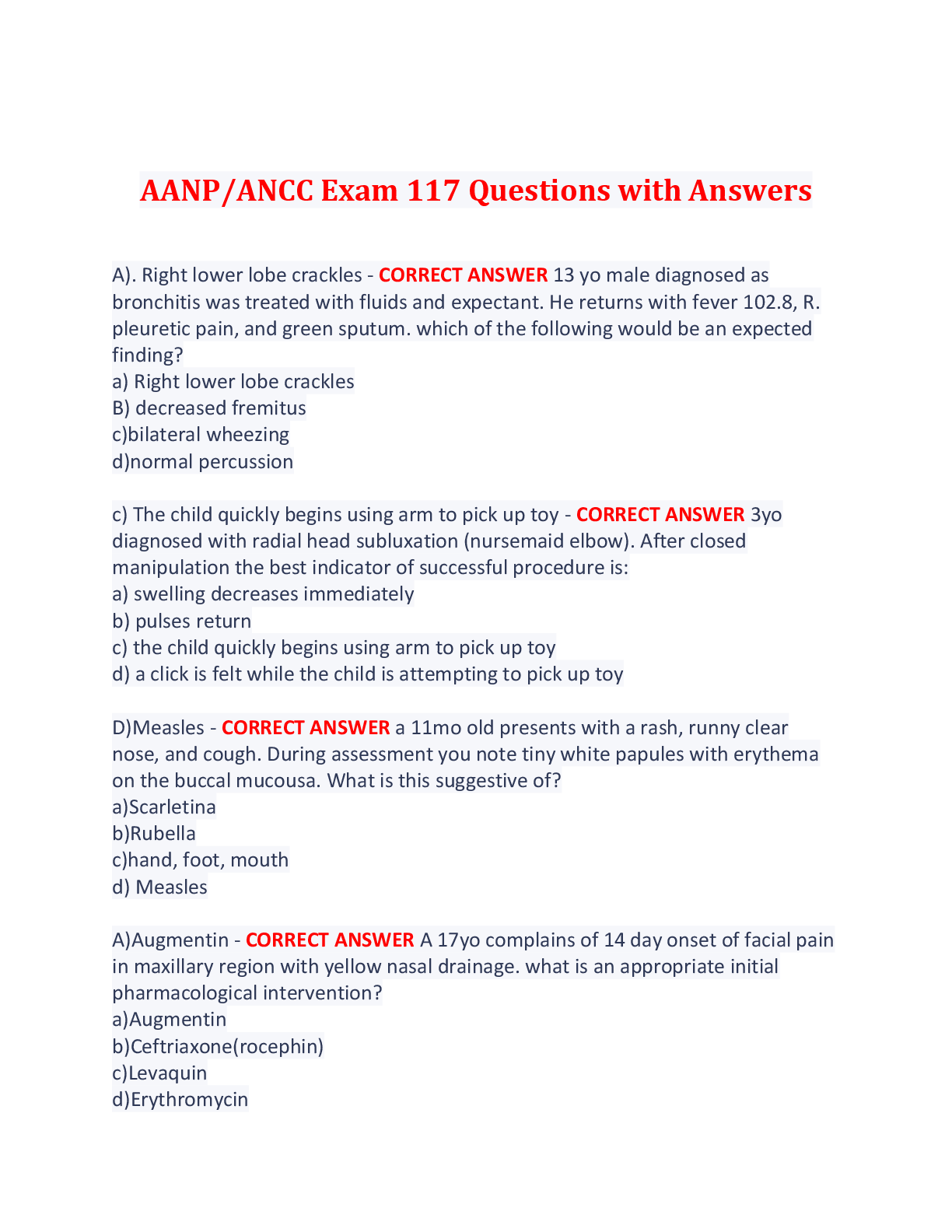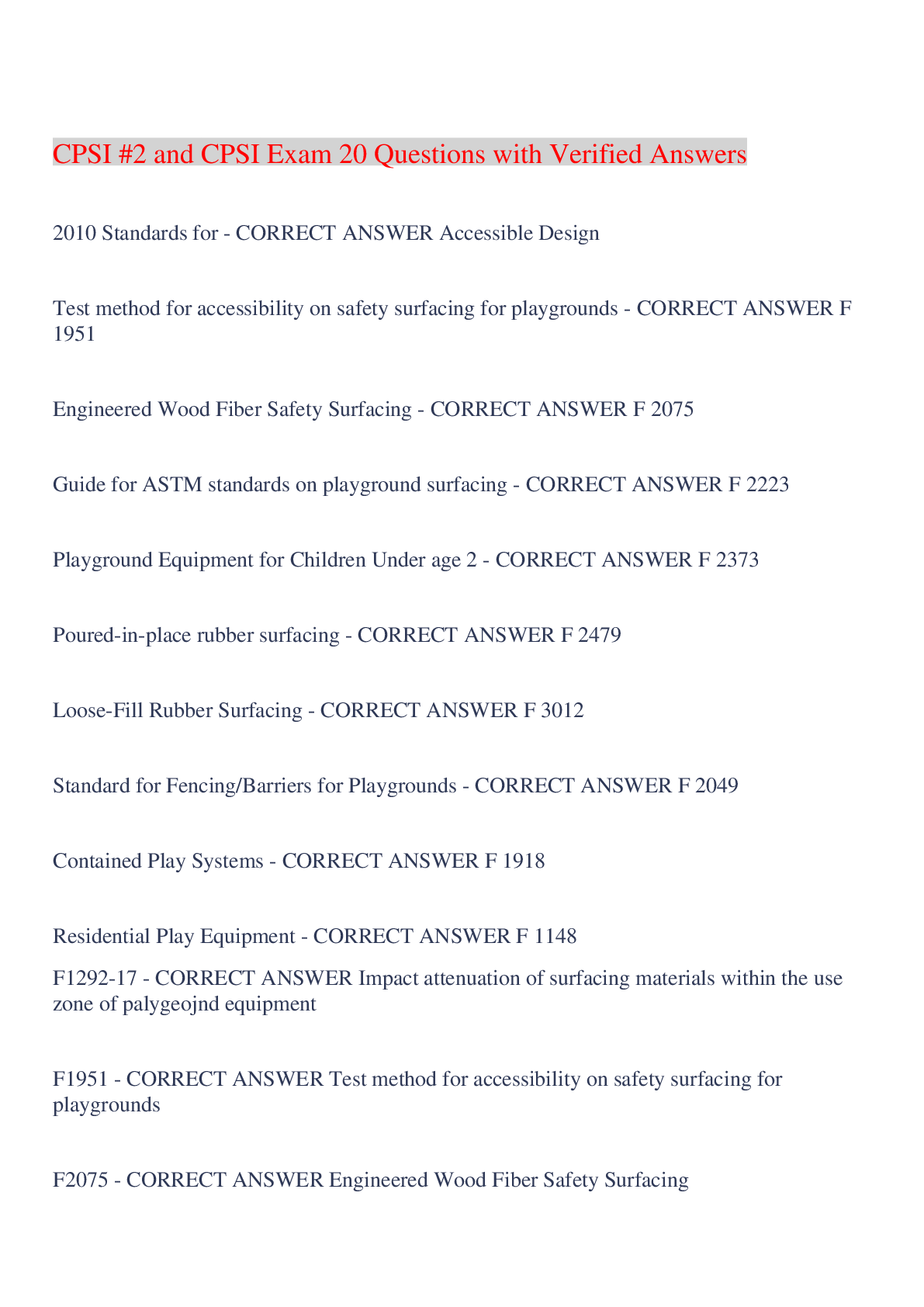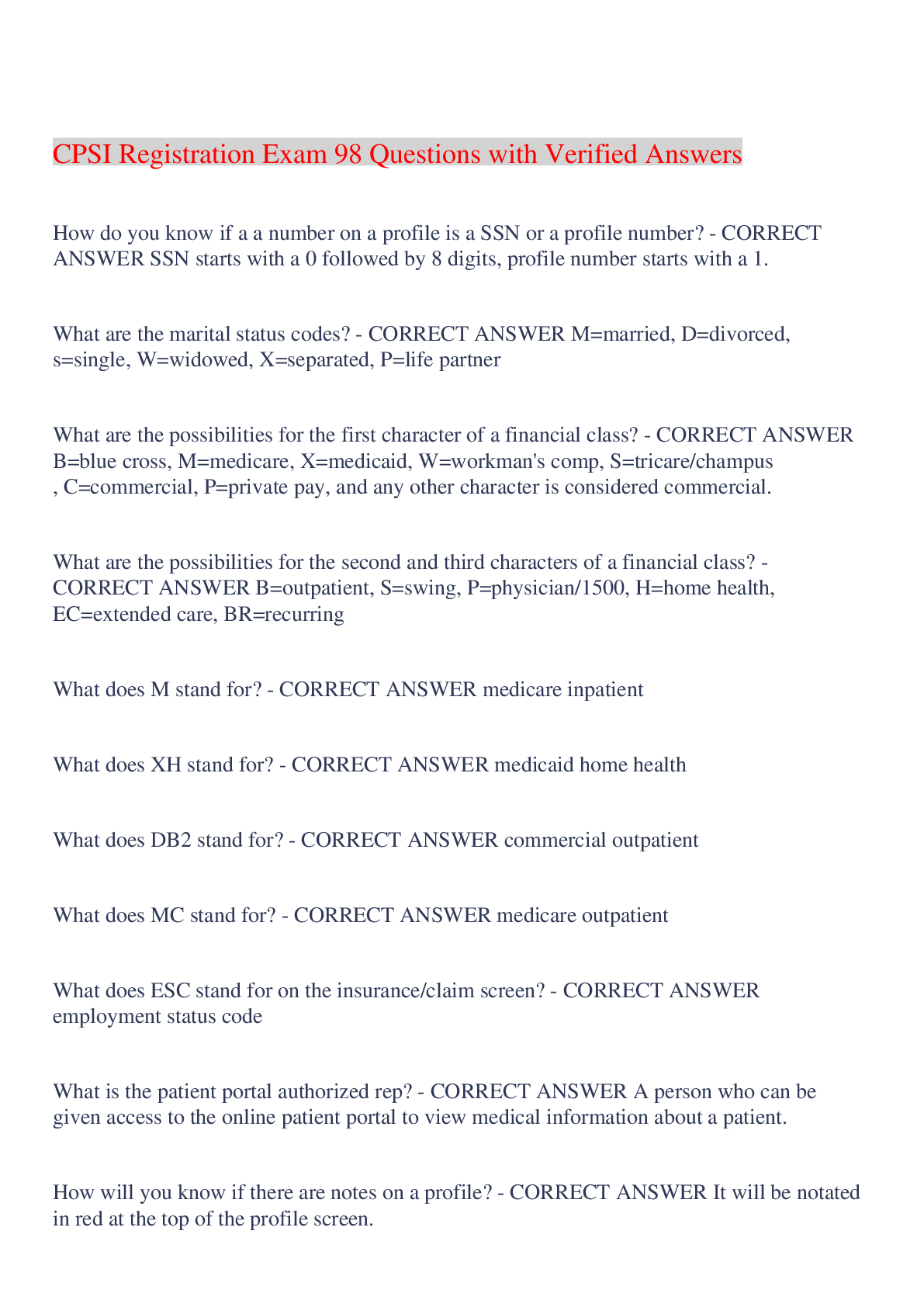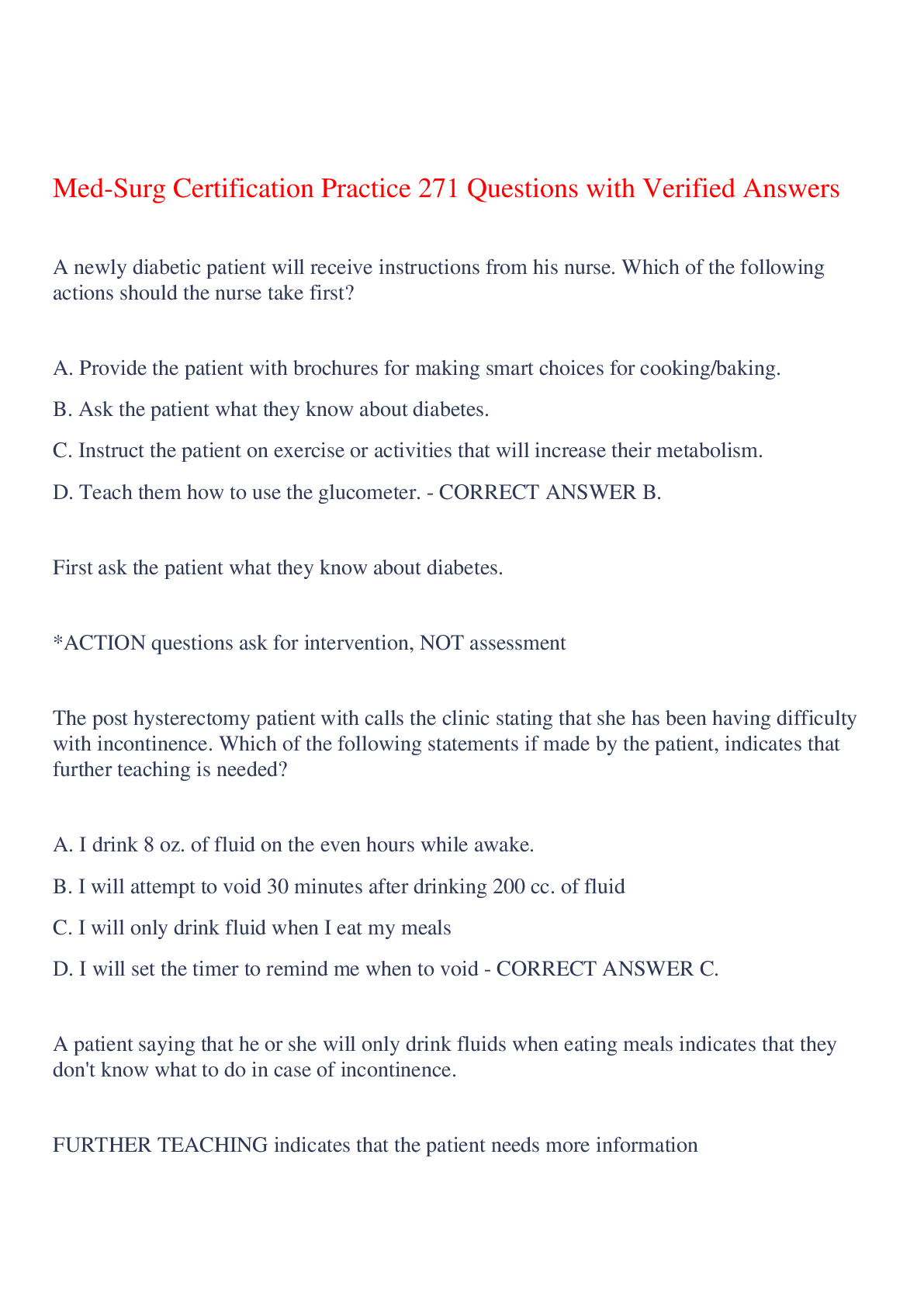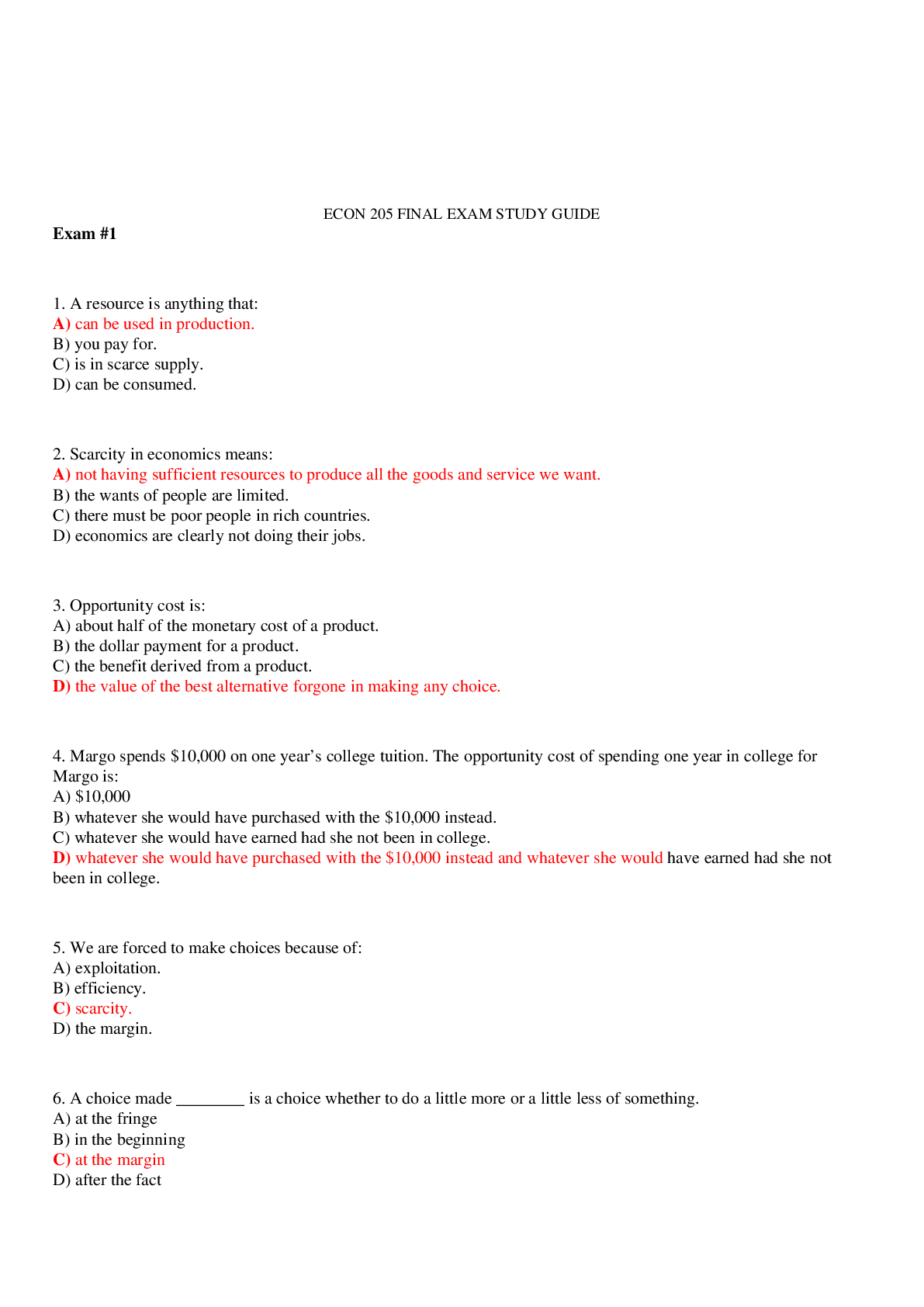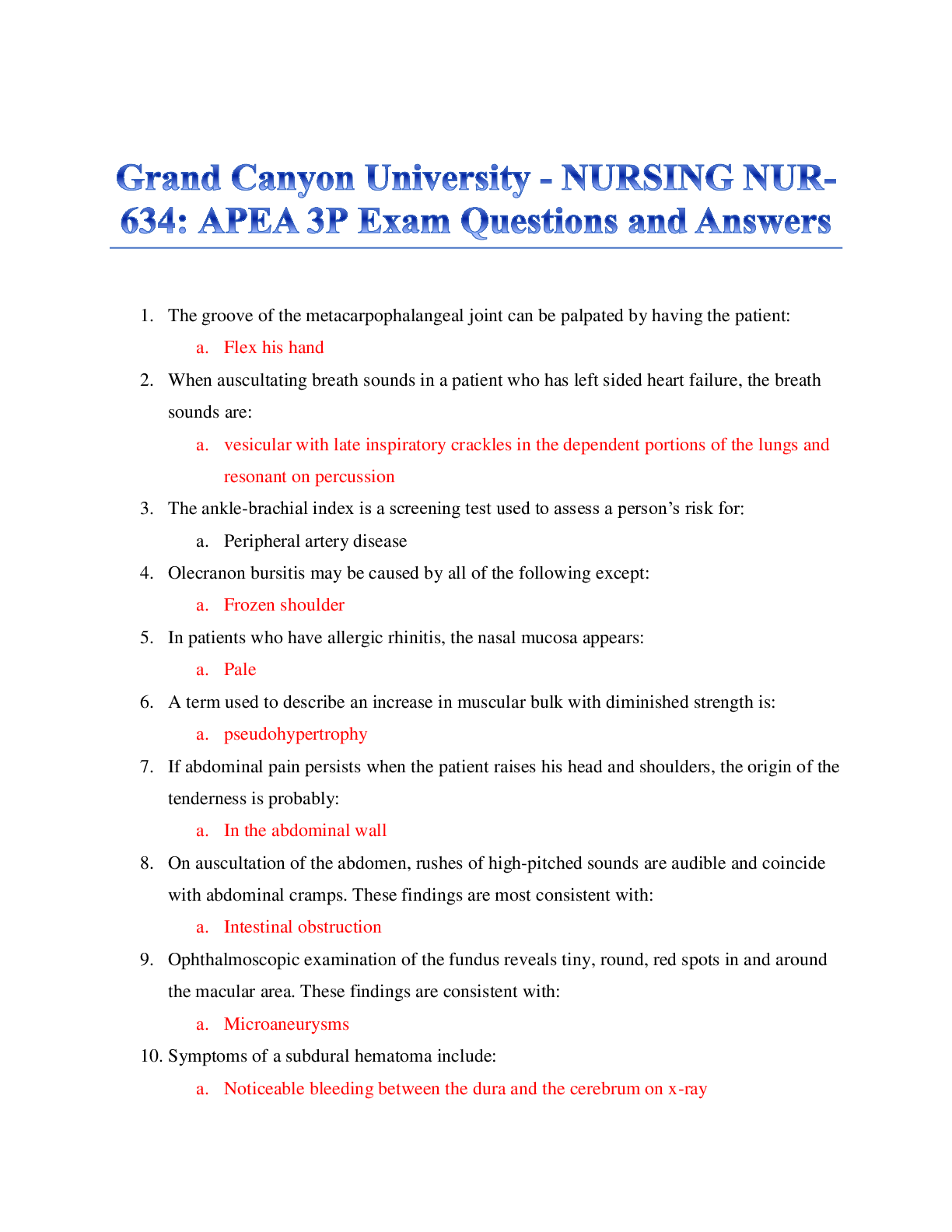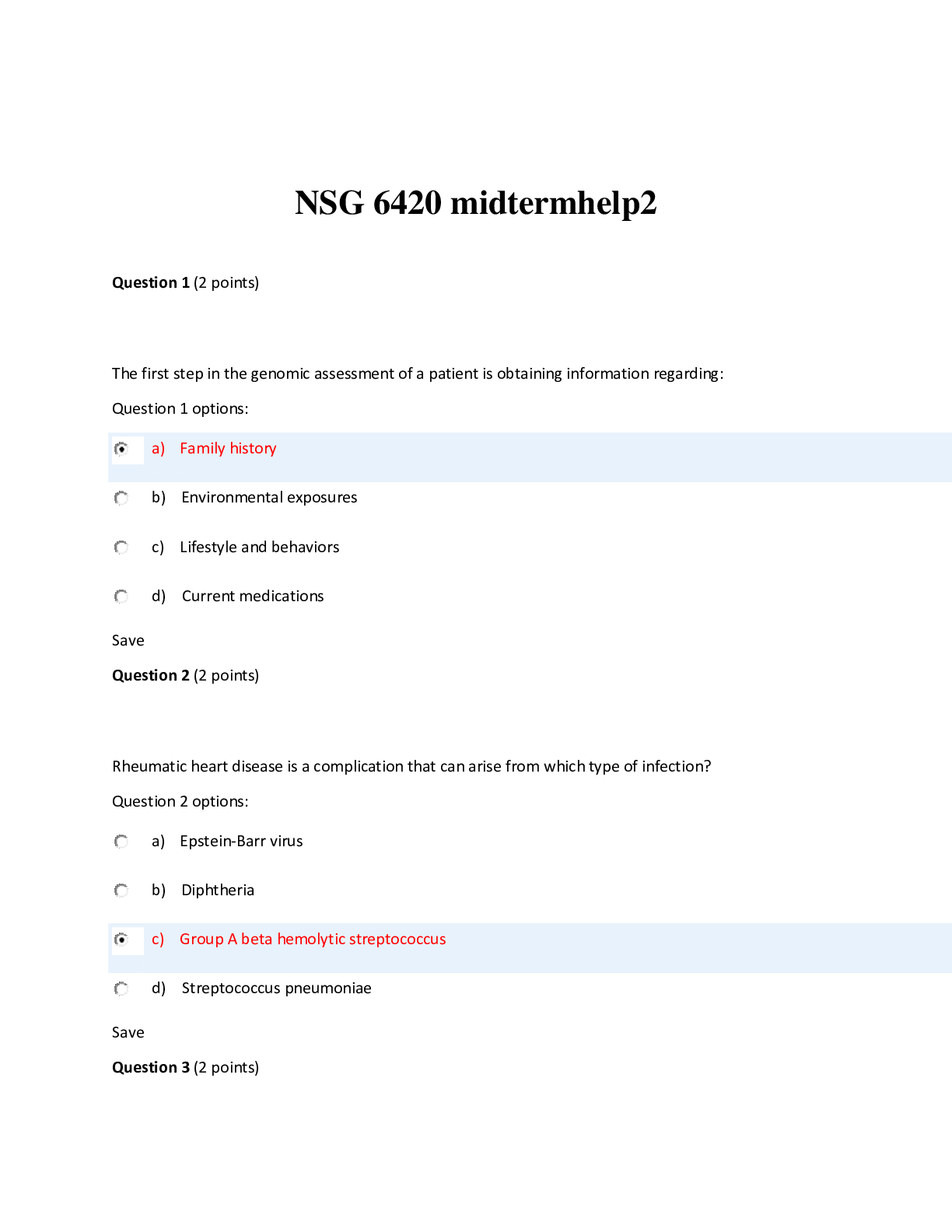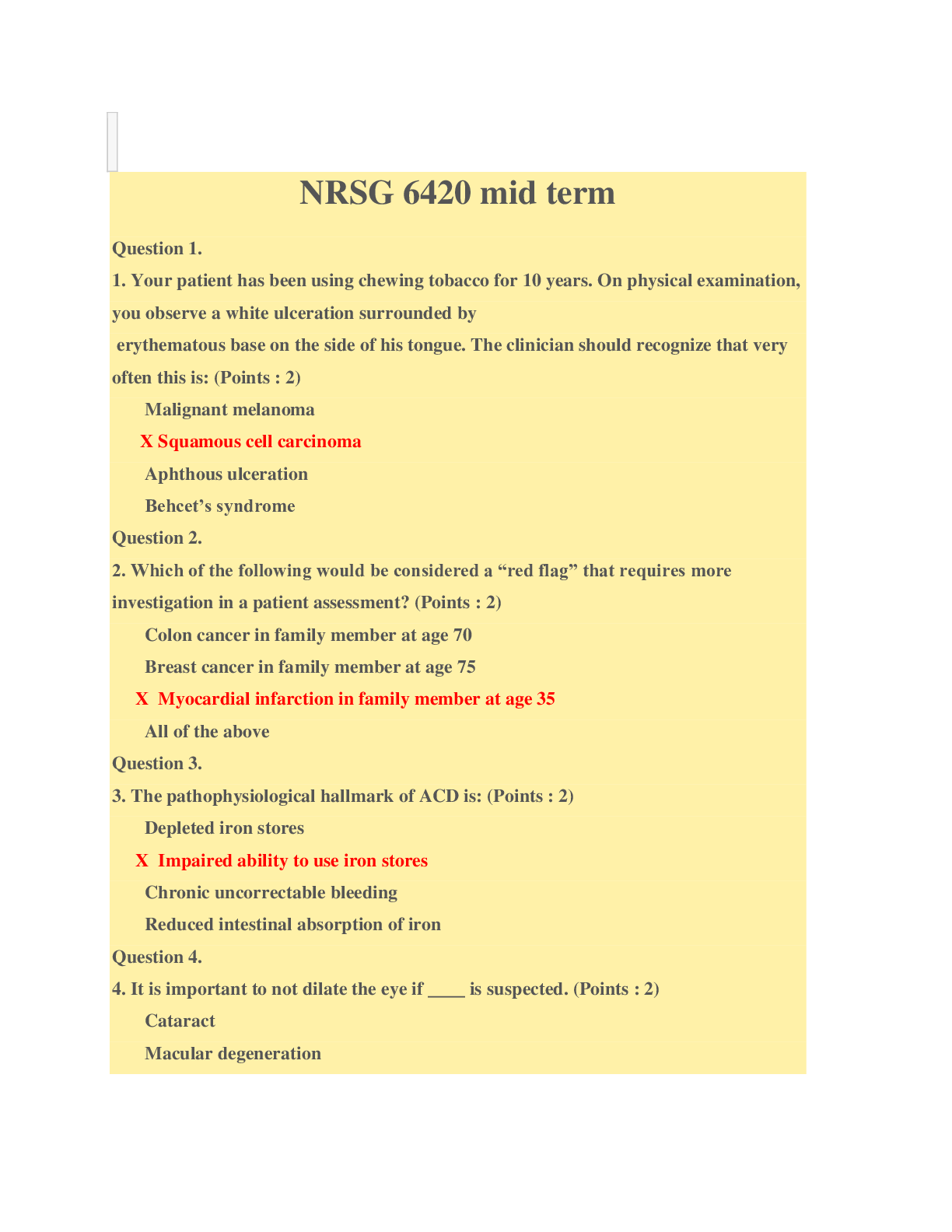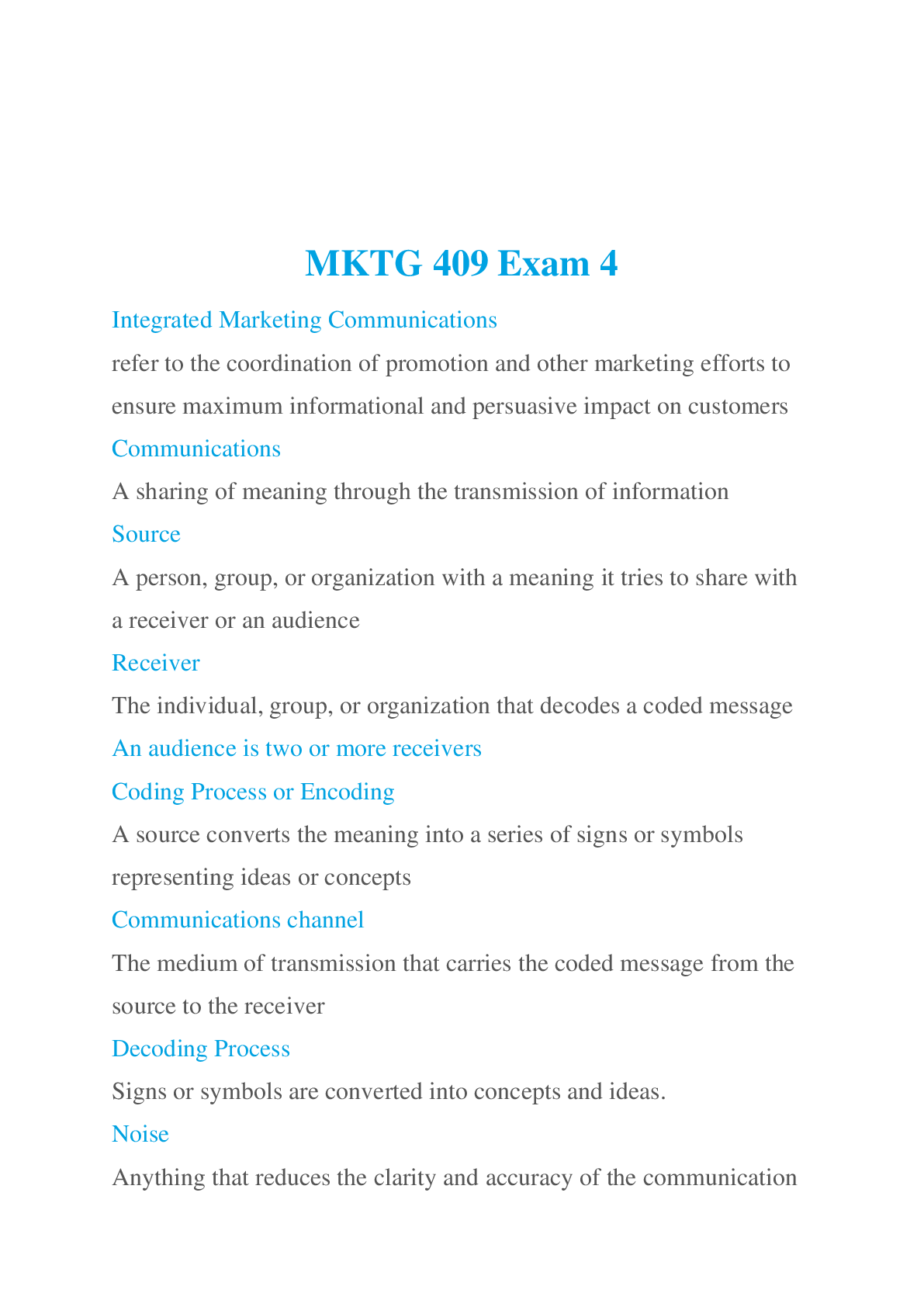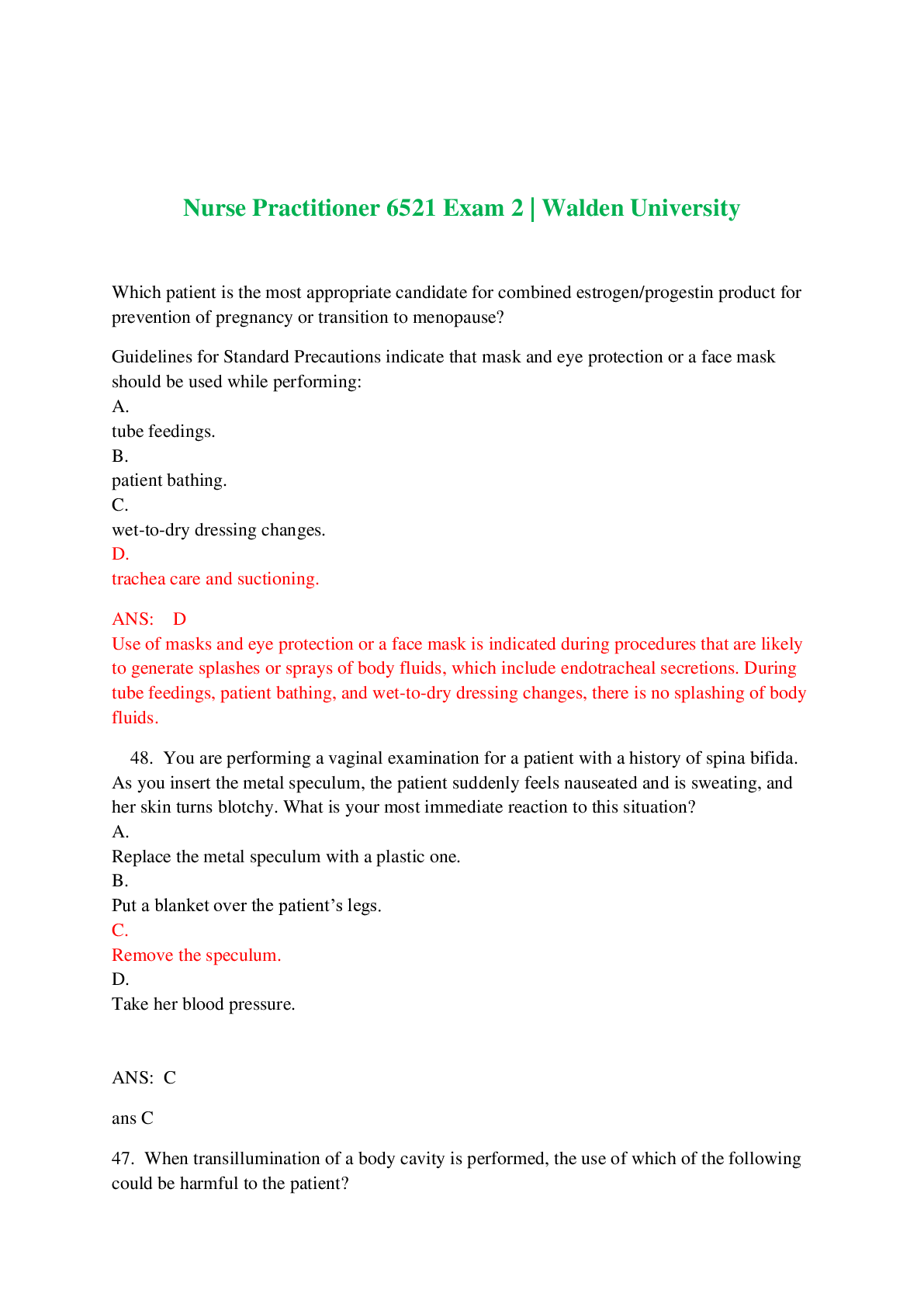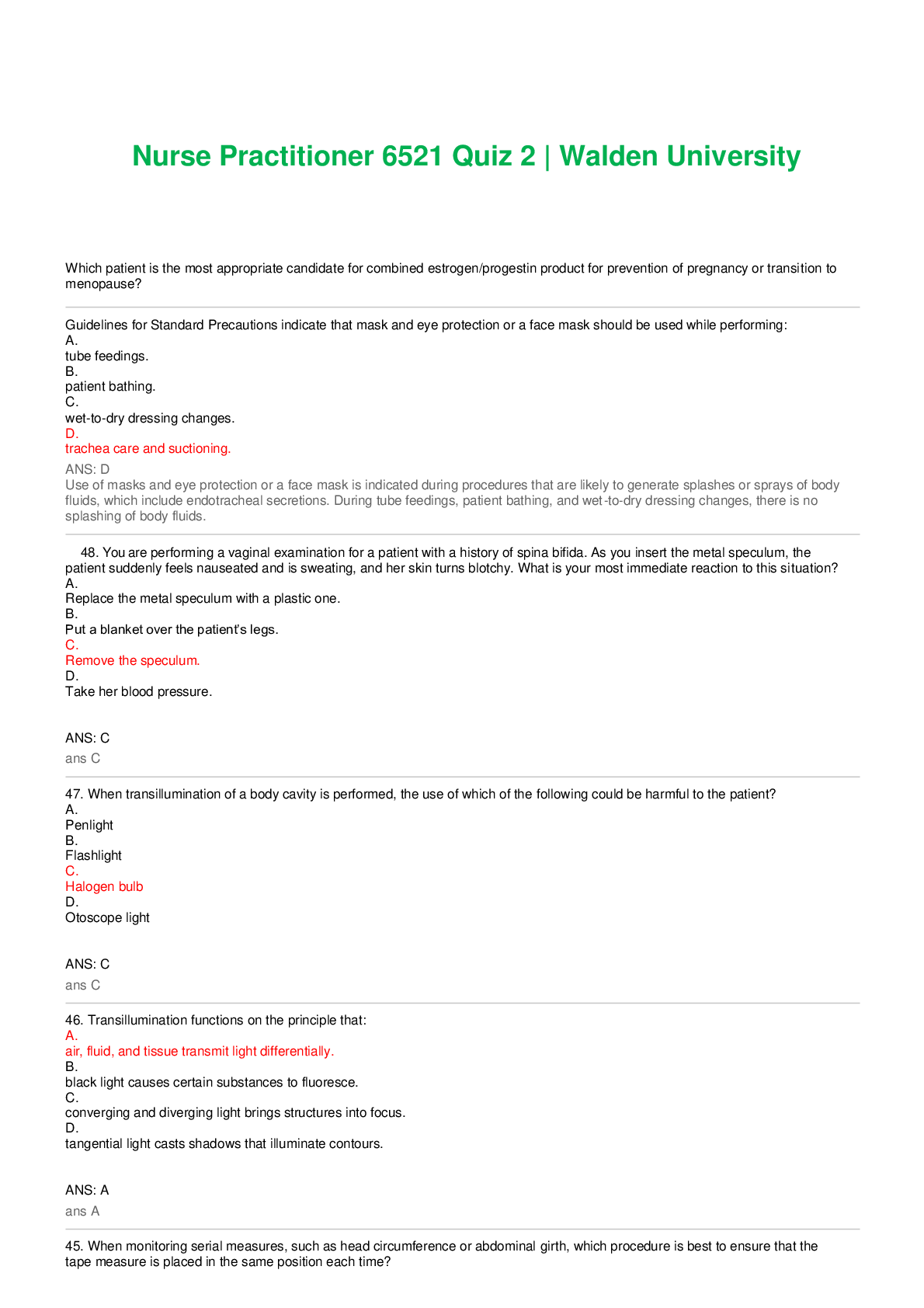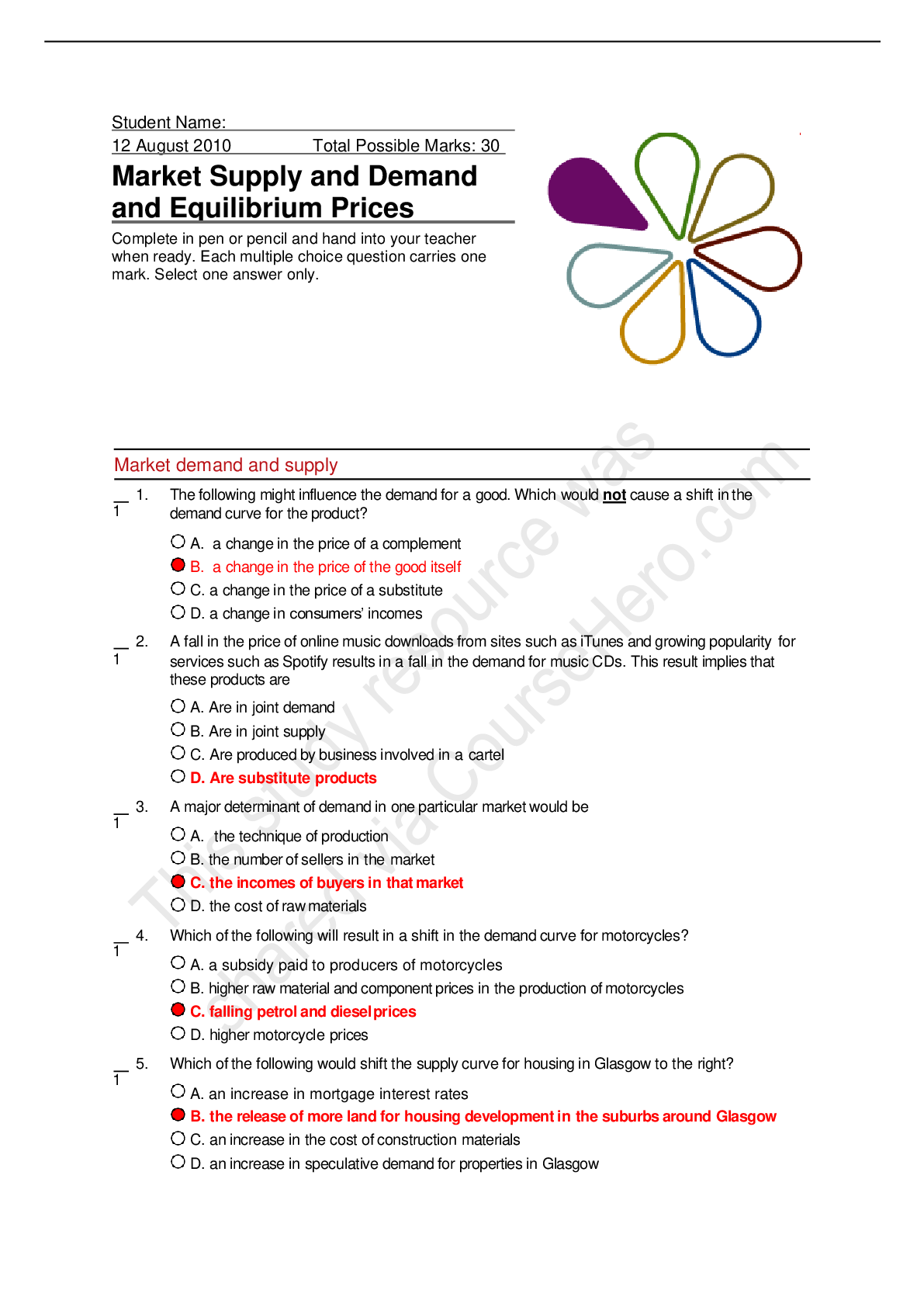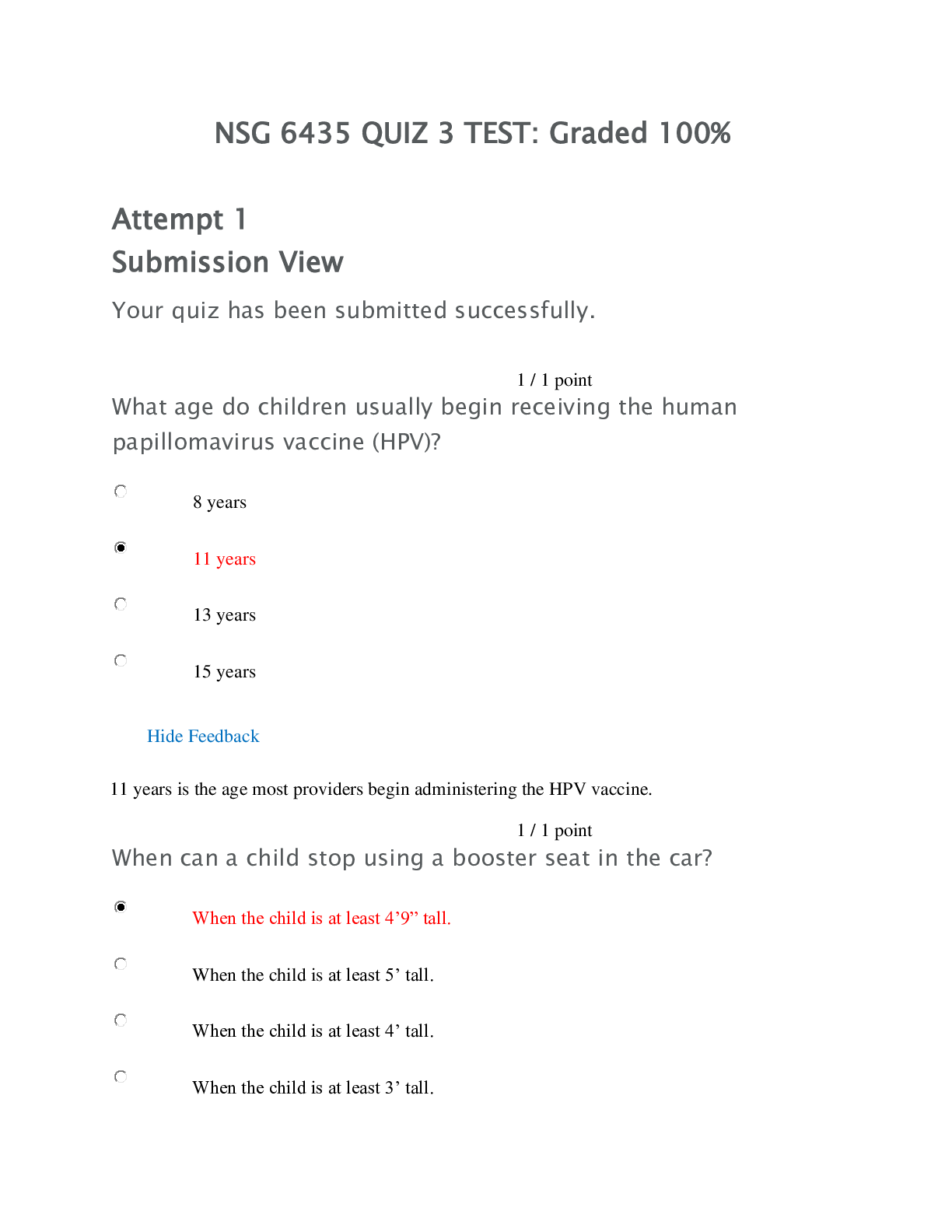Rasmussen MDC Exam 2_LATEST 2022 Questions and Answers,100% CORRECT
Document Content and Description Below
Rasmussen MDC Exam 2_LATEST 2022 Questions and Answers Remaining still for hours, sitting for long periods of time, anything that prevents circulation - Clients at risk for DVT - Handrails in ... bathrooms - Ramps instead of stairs - Wear rubber sole shoes - Avoid scatter rugs - Prevent clutter - Avoid slippery floors - Prevention of falls - Increased intraocular pressure in a hollow organ. - When the intraocular pressure increase it leads to compression of the retinal blood vessels and photoreceptors and their nerve fibers resulting in hypoxemia and death of the tissue and loss of vision. - Assure the patient can administer own eye drops correctly - Keep follow-up appointments every 1-3 months to evaluate the IOP. - If the patient had surgical treatment be sure to educate on the S&S of hemorrhage and detachment including severe pain, and vision loss. These should be reported immediately to HCP. - Glaucoma teaching and pathophysiology - Maintain perfusion, improve comfort, and prevent impaired mobility - Prioritization of care for a fracture - Handle with the palms of your hands, have patient report painful "hot spots" under the cast which might indicate area of pressure necrosis, instruct patient to never put anything down into the cast, encourage the patient/family to smell the area for mustiness or unpleasant odor (if ignored the patient may develop a fever). - Assess skin color and temperature, sensation, mobility, pain, capillary refill, and pulses distal to the fracture site. CMS- circulation, movement, and sensation. - Cast education and assessment - Infection of the bone. May be acute or chronic. - Educate about medications, encourage compliance and to follow regimen (take full course of medications), inform about signs and symptoms, provide comfort during rest and with positioning, assist in ADL, coordinate physical therapy while in the hospital to help improve mobility especially after surgery, provide mobility assistance devices. - Osteomyelitis prevention and treatment methods - Gonioscopy is used when elevation intraocular pressure is diagnosed to determine if the glaucoma is open-angle or closed-angle. It allows the visualization of the angle where the iris meets the cornea. - Test to determine open vs closed angle glaucoma - CMS: circulation, mobility, sensation. Assess skin color, temperature, sensation, mobility, pain, capillary refill, and pulses. - Neurovascular assessment - P: Palliative, Q: Quality, R: Region, S: Scale, T: Time - Pain assessment - The great toe shifts laterally, and the first metatarsal head of the great toe enlarges - Pain especially when shoes are worn - Treatment: custom made shoes or surgery - Bunions (hallux valgus) - Perform passive ROM exercises for patients who are immobile - Turn and reposition every 2 hours - Assess for skin redness - Priority assessments for immobile patients - A continuous ringing or noise perception in the ears. - Tinnitus Also called farsightedness. Occurs when the eye does not refract light enough. As a result, images actually converge behind the retina. Distant vision is normal, but near vision is poor. - Hyperopia - Decreases all muscle strengths including the lungs, increases secretion (aspiration pneumonia is a risk), decrease ventilation capacity in response to exercise, respiratory depth decreases affecting ventilation, air passage blockage can lead to atelectasis (collapse of air sacs or alveoli). - Immobility consequences on the respiratory system Paralysis of one side of the body - Hemiplegia Paralysis of the lower portion of the trunk and both legs - Paraplegia Partial or incomplete paralysis - Paresis Paralysis of all four extremities. - quadriplegia - Used for partial weight-bearing, both feet; faster, but less support than a 4-point gait. - Two-point gait Non-weight bearing; faster than a 4-point gait; can use with a walker - Three-point gait Used for partial weight-bearing, both feet; patient must shift weight constantly. - Four-point gait - Step 1: Be in an upright position with head slightly tilted back - Step 2: Don procedure gloves - Step 3: Cleanse the edges of the eyelid from the inner canthus to the outer canthus. - Step 4: Gently rest the dominant hand on the forehead. - Step 5: With the nondominant hand, pull the lower lid down to expose the conjunctival sac. - Step 6: Position the eye dropper about 1.5 to 2.0 cm above the patient's eye. Ask the patient to look up, and drop the prescribed number of drops into the conjunctival sac. Do not let the dropper touch the eye. - Step 7: Ask the patient to gently close their eyes as it helps distribute the medicine. - Step 8: If the medication has systemic effects, press gently against the side of the nose for 1 to 2 minutes to close the lacrimal ducts. - Eye drop administration education - Avoid standing in one position for a long period of time - Do not lock your knee when standing - Keep core tight - Do not bend forward at the waist or neck - Sit at a comfortable height when at the desk - Do not wear high-heeled or platform shoes for a long period of time - Do not slump when sitting - Sit close to your work - Use back support - Sit with your feet flat on the floor and knees below your hips - Sleep on a firm mattress - Proper body mechanics (body alignment, coordination, balance, joint mobility) 30 degrees - Semi-Fowler's 45-90 degrees - High-Fowler's Patient leans forward to help with respiration. Used in SOB. - Orthopneic Side-lying with legs in line - Lateral position Lying semi to the side with leg slightly bent - Oblique position Lying on the stomach - Prone Lying lateral and semi on the stomach (semi-prone). - Sim's position Lying on the back - supine position - Immobility, acute compartment syndrome, hemorrhage or hypovolemic shock, fat embolism syndrome, venous thromboembolism, infection, avascular necrosis, delayed union, and complex regional pain syndrome - Complication of fractures - Related to the muscle, blood vessels and nerves are caught within the fascia leading to the increase in the venous pressure and the resulting edema. - Compartment syndrome Wood or plastic device to assist with moving the patient - Transfer board Hydraulic devices to transfer patients - Mechanical lift - Heavy belt several inches wide to facilitate transfer or secure holding the patient while they ambulate. - Transfer belt - Health history, demographic data, genetic considerations, menstrual and menopause history, nutrition, endocrine history, physiological changes, assess pain level with activity, assess for fractures, assess mobility function, and assess the patient psychosocial status. - Assessment of osteoporosis Consolidation and remodeling of bone continue to meet mechanical demands. This process may start as early as 4 to 6 weeks after fracture and can continue for up to 1 year. Depends on the severity of the injury and the age and health of the patient. - Fifth stage of bone healing - Perform "heel pump" activities - Drink adequate fluids - Compression stockings - Exercise - Remain active - DVT prevention - Increased cardiac workload, risk for orthostatic hypotension, risk for venous thrombosis - Cardiovascular effects of immobility - Decrease muscle size, tone, and strength. Decreased joint mobility and flexibility. Bone demineralization. Decreased endurance and stability. Increased risk for contracture formation. - Musculoskeletal effects of immobility - Decreased depth of respiration, decreased rate of respiration, pooling of secretions, and impaired gas exchange. - Respiratory effects of immobility - The second step of the nursing process. This is the phase in which you use your critical-thinking skills to analyze the assessment data. - Nursing diagnosis - Release of fat globules from the yellow bone marrow into the blood vessels within 12 to 48 hours following the fracture. - Fat embolism syndrome - Independent joint movements. It requires the client to move the joint through its full ROM. - Active ROM - Dependent joint movement. Is used when the client is unable to exercise each joint independently. Instead, you support the body and move each joint through its ROM. - Passive ROM - Goal: Maintain optimum vision by complying with treatment regimens. - Treatment: Prescribed eye drops every 12 hours - Glaucoma goals and treatment - The surgeon views the fracture site and places pins, screws, plates and sometimes prosthesis to allow the bone to heal. - Open reduction internal fixation (ORIF) - Opioid-Oxycodone, Non-opioid, anti-inflammatory, and muscle relaxants - Pain management with fracture patients - You must determine the status, or type, of each nursing diagnosis (or patient concern). Is it an actual (signs and symptoms are present), risk (potential- problem may occur), possible (problem may be present), syndrome (several related problems are present), or wellness nursing diagnosis (no problem is present)? - Identifying priority nursing diagnosis Also called nearsightedness. Occurs when the eye overbends the light and images converge in front of the retina. Near vision is normal, but distance is poor. - Myopia Within 24 to 72 hours a hematoma forms at the site of the fracture. - First stage of bone healing Occurs in 3 days to 2 weeks when granulation tissue begins to invade the hematoma. This prompts the formation of fibrocartilage, providing the foundation for bone healing. - Second stage of bone healing Occurs as a result of vascular and cellular proliferation. Within 3-6 weeks the fracture site is surrounded by new vascular tissue (callus is the beginning of a nonbony union). - Third stage of bone healing In 3-8 weeks, the callus is gradually resorbed and transformed into bone. - Fourth stage of bone healing [Show More]
Last updated: 3 years ago
Preview 1 out of 7 pages

Buy this document to get the full access instantly
Instant Download Access after purchase
Buy NowInstant download
We Accept:

Reviews( 0 )
$15.00
Can't find what you want? Try our AI powered Search
Document information
Connected school, study & course
About the document
Uploaded On
Feb 04, 2022
Number of pages
7
Written in
All
Additional information
This document has been written for:
Uploaded
Feb 04, 2022
Downloads
0
Views
128






